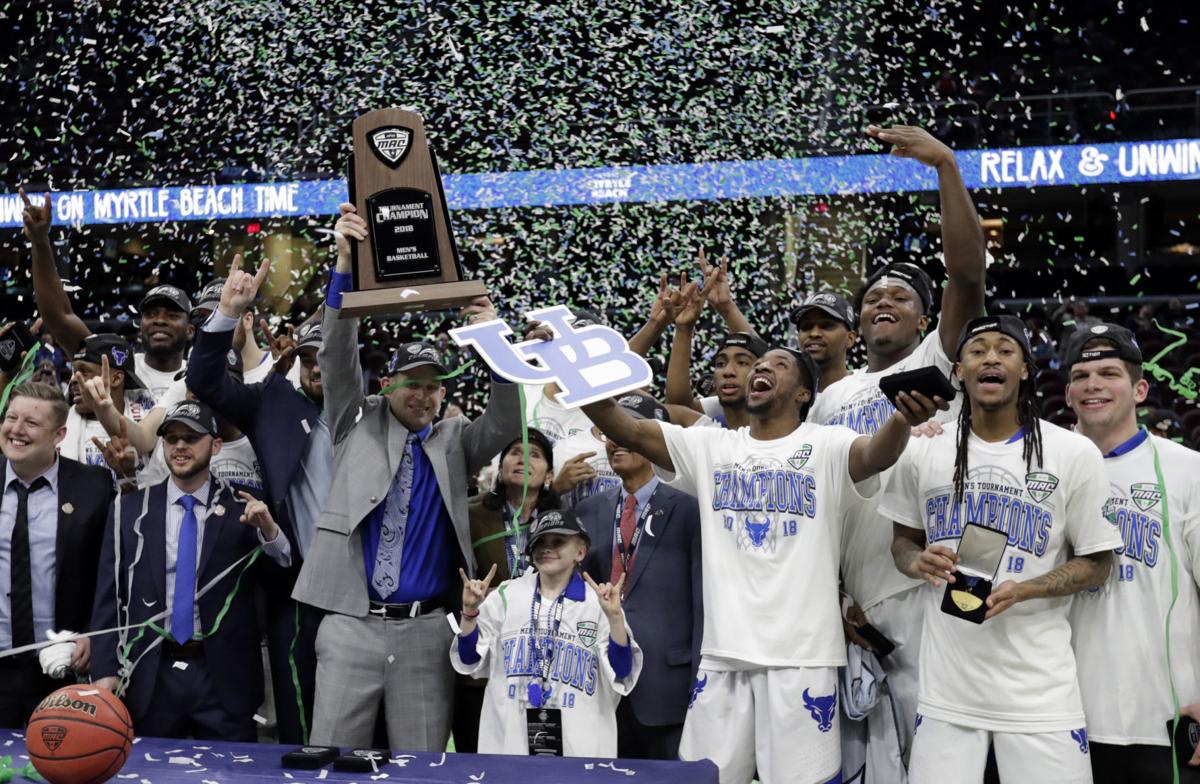The NCAA created No. 13 seeds in 1985. It gave life to the Richmond Spiders, the Manhattan Jaspers and the Valparaiso Crusaders, 13 seeds one and all — and winners, too.
By 1998, No. 13 seeds had won 10 first-round NCAA Tournament games. Middle Tennessee State, Princeton, Missouri State. Lots of teams who had never been given a look by the NCAA Selection Committee were suddenly on TV, dancing.
Arizona’s opponent in Thursday’s first-round of the NCAA Tournament is 13th-seeded Buffalo. It was long ago established that 13-seeds are not lightweights.
No Bull.
You might remember highlights of the Vermont Catamounts, the UNC-Wilmington Seahawks and the Hawaii Rainbows — 13-seeds all — doing a victory dance. And Morehead State, too.
Since 1985, No. 13s have gone 25-107. That’s a 19 percent success rate. It’s almost a roll of the dice. Other 13-seed winners: LaSalle, Murray State, Siena, Kent State.
It makes the tournament irresistible.
Before the creation of 13s, there were byes.
In each of John Wooden’s first nine NCAA championships, UCLA received a bye into the tournament. They opened in the Sweet 16. The Bruins went 4-0 — nothing close to today’s backbreaking 6-0 — to win nine national titles.
This isn’t to discount Wooden’s accomplishments; most of the era’s powerhouses benefitted from byes. North Carolina had byes to the Sweet 16 in 1966, 1967, 1968 and 1969.
As recently as 1980, the NCAA gave byes to the 16 highest seeded teams. It allowed the NCAA to expand the field from 32 to 48, but almost immediately the bye process was the target of criticism for the silliest of all reasons: Coaches argued that winners of the play-in games had unfair advantages.
The advantages? They had overcome stage jitters and established momentum and confidence.
It sounded irrational, but it was actually true. Seven of the 16 who received byes in the 1980 first round — including Pac-10 champion Oregon State, No. 1 seed DePaul and North Carolina — all lost to those who had survived a play-in game.
Coaches and athletic directors pleaded for a better system, but byes continued for another four seasons. By the time the NCAA abolished byes in 1985 and went to a 64-team field, 27 of the 80 who received byes had lost. That’s a third of the field.
Perhaps the best team in Arizona State history, the 24-4 club of 1981, was given a bye and unfairly sent to Wichita, Kansas, where it lost to the nearby Kansas Jayhawks, who beat Ole Miss in a play-in game.
The byes didn’t work. So in 1985, the NCAA introduced the 13 seed.
Since then the tournament has been more equitable and far more intriguing. Maybe it’s not a thing of beauty — and certainly not one free of criticism — but it is a better model and it helped to create one of America’s most endearing sporting events.
The problem now, as always, is the selection process. It’ll always be that way.
When TV cameras captured Arizona State’s Bobby Hurley and his Sun Devils diving into his swimming pool, celebrating ASU’s controversial selection on Sunday, the league did not soak it in.
USC, who finished second in the conference to ASU’s ninth, and who clearly passed the eye-test over the Sun Devils, did not take a dip.
The selection process has evolved significantly over the years, yet it rarely keeps the customers satisfied.
On Tuesday, former Arizona athletic director Jim Livengood, chairman of the 2003 selection committee, said “you can play your way out of a ‘bad seed’ but not if you’re not in the Tournament.”
Tell that to the Trojans.
When Arizona was selected to its first NCAA Tournament in 1951, the selection committee was a trio of the most powerful men in college sports: Asa Bushnell, commissioner of the East Coast Athletic Conference; Dutch Lonborg, athletic director at Kansas, and Reaves Peters, commissioner of the Big Seven Conference, now the Big 12.
They selected 16 teams. The process kept changing. In the early ’70s the selection committee, expanded to 10, determined first-round byes on the basis of a conference’s win-loss record over the previous 10 NCAA tournaments.
That wasn’t fair to the little guy.
It meant the future 13-seeds such as today’s Buffalo, UNC-Greensboro, Marshall and College of Charleston, were on a treadmill to nowhere.
Given an ever-changing system, the 13th-seeded Bulls, Spartans, Thundering Herd and Chanticleers take their best shot at schools like Arizona.
After USC was omitted, unhappy Pac-12 commissioner Larry Scott said “I understand the complexities and the challenges the committee has and respect following their criteria. But I can only be left with the conclusion that some of the criteria should be re-evaluated.”
One thing to remember about the 10 men on the selection committee: They serve five-year terms and have few peers in overall knowledge of, say, the nation’s top 100 teams.
They don’t even get paid. They take time off from work — or sometimes juggle two jobs — in attempt to get the most appropriate No. 4-seeds and 13-seeds.
It’s hard. It is always open to a few tweaks.
“I really think a much more careful examination needs to take place in seeding and bracketing,” Livengood said. “It’s particularly important in who higher-seeded teams have to play in the second round. It’s not an easy job and certainly incredibly open to criticism.
“I do think we’ll see some process changes going forward.”
Just like those of the last 70 years.





